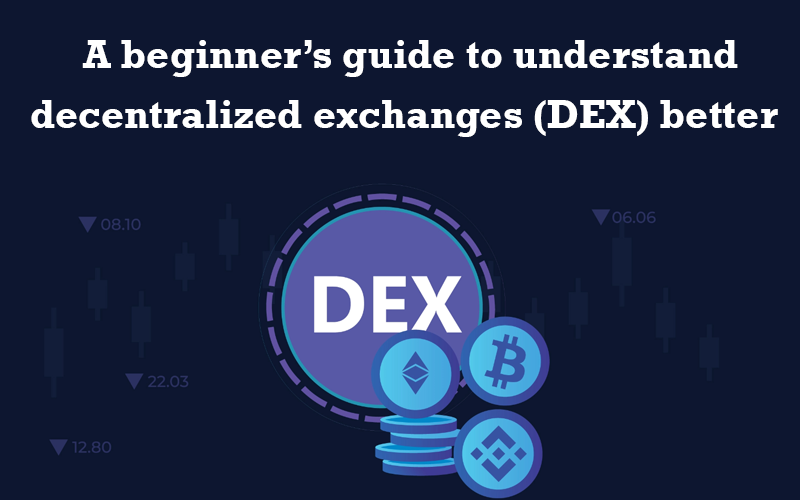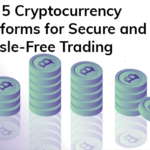A beginner’s guide to understand decentralized exchanges. What Are Decentralized Exchanges (DEX)? Decentralized Exchanges (DEX) are a type of cryptocurrency exchange that operates on a blockchain network. This allows them to access their assets and private keys, which are required to interact with the smart contracts. They allow users to trade cryptocurrencies directly with one another, without the need for a centralized intermediary. A beginner’s guide to understand decentralized exchanges. This allows for greater security, as users retain control of their own private keys and assets, and increased privacy, as transactions are recorded on a blockchain rather than a centralized server.
In a DEX, the exchange is not controlled by a single entity but rather is run by a network of users. This allows for more decentralized control and eliminates the need for a trusted third party to hold and manage user funds.
DEXs are typically built on smart contract platforms like Ethereum, where users can interact with the smart contracts through a user interface (UI) provided by the DEX.
Some of the benefits of DEXs include greater security, increased privacy, and reduced risk of hacking or theft. However, DEXs tend to have lower trading volumes and fewer trading pairs compared to centralized exchanges. Additionally, DEXs tend to have lower liquidity, which can lead to wider bid-ask spreads.
DEXs are decentralized cryptocurrency trading platforms that operate on a blockchain network. They allow traders to keep custody of their assets, and remove the risk of a centralized entity misusing assets or taking them away altogether.
Key features of DEXs
- Decentralized control: The exchange is not controlled by a single entity, but rather is run by a network of users.
- P2P trading: Users can trade directly with one another, without the need for a middleman.
- Increased security: Because users retain control of their own private keys, there is less risk of funds being hacked or stolen.
- Greater privacy: Transactions on a DEX are typically private, as they are recorded on a blockchain rather than a centralized server.
- Limited trading options: DEXs typically have smaller trading volumes and fewer trading pairs compared to centralized exchanges.
- Lower liquidity: DEXs are less liquid than centralized exchanges, which can lead to wider bid-ask spreads.
How Do Users Interact With a DEX?
Users interact with a Decentralized Exchange (DEX) by interacting with the smart contracts that run on the blockchain. The user interface (UI) provided by the DEX allows users to access and interact with the smart contracts, which are responsible for managing the exchange of assets.
Users typically connect to the DEX using a software wallet that supports the same blockchain network as the DEX. This allows them to access their assets and private keys, which are required to interact with the smart contracts.
Once connected, users can view the available trading pairs and order book, and submit buy or sell orders, which are recorded in the smart contract. Orders are matched with other users’ orders based on price and other criteria, and the assets are then transferred directly between the users’ wallets.
Some DEXs also require users to stake or lock up a certain amount of the assets they want to trade as collateral. This is to ensure that users have enough assets to settle their trades and to prevent market manipulation.
Will Decentralized Exchanges ever become mainstream?
Decentralized Exchanges (DEXs) have been around for a few years now, but they have yet to become mainstream. However, it is possible that DEXs will become more popular in the future as people become more aware of the benefits they offer, such as greater security and privacy, and as the technology and user interfaces continue to improve.
One of the main challenges that DEXs face is low liquidity, which can lead to wider bid-ask spreads and slower order execution. This makes it less attractive for traders and investors, especially those who trade in larger volumes.
Another challenge is the lack of regulation in the DEX space. Centralized exchanges are heavily regulated, which provides some level of protection to investors. DEXs are not currently subject to the same level of regulation, which can make some users hesitant to trade on them.
Additionally, the adoption of DEXs is still limited by the fact that most users are not familiar with using decentralized platforms and the technology can be confusing for some.
Despite these challenges, DEXs are making progress, and it is expected that as the technology improves and user interfaces become more user-friendly, DEXs will become more accessible and appealing to a wider audience. Also, with the rise of decentralized finance (DeFi) and the growing interest in non-custodial solutions, DEXs are expected to play a major role in the crypto ecosystem in the long term.
Risks of Decentralized Exchanges
Decentralized Exchanges (DEXs) have some inherent risks that are different from centralized exchanges. Here are some risks to consider when using DEXs:
- Smart contract risks: DEXs rely on smart contracts to manage the exchange of assets. If a smart contract has a bug or vulnerability, it could result in the loss of funds for users.
- Lack of regulation: DEXs are not currently subject to the same level of regulation as centralized exchanges, which can make them more susceptible to fraud or hacking.
- Limited liquidity: DEXs tend to have lower trading volumes and fewer trading pairs compared to centralized exchanges, which can lead to wider bid-ask spreads and slower order execution.
- Lack of insurance: Most centralized exchanges offer some form of insurance to protect users’ funds in case of hacking or other security breaches. DEXs do not typically offer this type of protection.
- Limited oversight: DEXs operates on a decentralized network, which means there is no central authority to monitor or intervene in the event of a problem.
- High volatility: Due to the limited liquidity and the lack of oversight, DEXs can be more volatile than centralized exchanges.
- Complexity: DEXs can be more complex to use for some users, especially those who are not familiar with decentralized platforms and the underlying technology.
It’s important to understand these risks and to conduct thorough research before using a DEX. It is recommended to only trade on reputable DEXs, and to only trade assets that you are comfortable losing.
Conclusion for Decentralized exchanges
In conclusion, Decentralized Exchanges (DEXs) offer a more decentralized and secure way to trade cryptocurrencies, as users retain control of their own private keys and assets. They also offer greater privacy, as transactions are recorded on a blockchain rather than a centralized server. A beginner’s guide to understand decentralized exchanges. However, DEXs also have some limitations, such as lower liquidity, fewer trading options, and a lack of regulation. It’s important for users to understand these risks and to conduct thorough research before using a DEX. Additionally, DEXs can be more complex to use for some users, especially those who are not familiar with decentralized platforms and the underlying technology. Despite these challenges, DEXs are making progress, and it is expected that as the technology improves and user interfaces become more user-friendly, DEXs will become more accessible and appealing to a wider audience in the long term.






















0 Comments